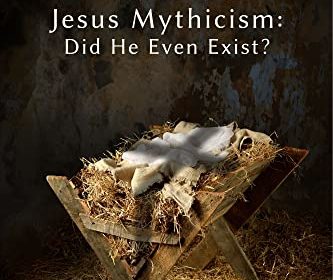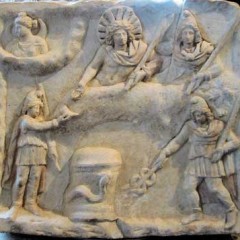The Myths of Jesus’ Childhood (by Dr. Robert Price)
No Account in Nazareth The earliest known gospel, Mark, has no tale to tell of Jesus before his baptism as an adult. There is nothing about a miraculous conception or birth, no angelic annunciation, no child prodigy stories such as we find in the other New Testament gospels. Considered as a historical figure (which despite all the mythology attaching to him, Jesus may have been), these is nothing at all odd that his early, private years should have nothing remarkable about them. But the more of a glorified mythic hero Jesus became in Christian imagination, his early life became a puzzle: if Jesus was from the very beginning a god on earth, what sort of childhood adventures must he have had? Surely the Son of the living God cannot have been merely cooling his heels in Nazareth all that time? The logic is precisely the same as that of Superman, Clark Kent, and Superboy. By Dr. Robert Price I am, as it happens, both a New Testament scholar and a huge comic book fan. Since comic books are the modern American myths, it is not surprising to find parallels between them and ancient myths. And these parallels can be quite helpful for understanding both literatures. In the present case, think of the first version of Superman. He came on the public scene as a superhero for the first time as an adult, in Action Comics, 1938, having whiled away his early years in Smallville. He took the alias Clark Kent and worked for the Daily Star (later the Daily Planet), then appeared publicly as Superman. His adventures proved so popular that he got a second title each month, Superman. But fans wanted even more, so a new title was added to answer the question many readers were asking: how can Kent keep the secret of his powers all those hours of every day at his desk, taking guff from Perry White and Lois Lane? Worse yet, how could he possibly have passed through childhood and adolescence without blabbing the secret of his super-abilities? The answer: he didn’t. Already in Smallville, according to the new, revisionist account, mild-mannered Clark Kent had countless adventures as Superboy. Eventually, the editors decided to push the whole thing back further, and we began reading the adventures of Superbaby! The same sequence occurs in the Jesus legend. From a half-historical story of Jesus as a teacher, healer, and exorcist, the early Christian imagination pushed back Jesus’ divine sonship to his childhood and birth and began filling in the gaps with new stories.(For that matter, as Wilhelm Wrede, Raymond E. Brown, John A.T....
What is Mythicism? (by Rene Salm)
The question is harder to answer than might first be suspected. I’ve been waiting a few years for the word “mythicist” to appear in dictionaries—applied, that is, to the Christ myth theory. To my knowledge, it hasn’t yet. “Mythicist” in mainstream dictionaries still refers to 1. a student of myths, or 2. an interpreter of myths. Wikipedia makes a disparaging nod in the direction of mythicism by calling it a “19th century theology.” Those who hold the view today are, presumably, passé. About a century ago, “mythicist” (Eng.) and “mythiste” (Fr.) did refer to those espousing the Christ myth theory. But thereafter the mythicist point of view was effectively forced out of discussion. Since the closing decades of the 20th century, mythicists have been slowly and laboriously clawing their way back into the discussion. Of course, we still aren’t quite there yet. Landmarks in the New Mythicism are largely anglo-American: the books of G. A. Wells in Britain (1970s -present), Doherty’s “The Jesus Puzzle” (1999/2009), Price’s books including “Deconstructing Jesus” (2000), Zindler’s “The Jesus the Jews Never Knew” (2003), and my “The Myth of Nazareth” (2008). The word “mythicist” is still neither used by, nor even known to, the majority of biblical scholars. It appears almost exclusively in discusssions by mythicists themselves, and they are relatively few in number. It is still very much a technical term on the fringe of biblical studies. At the beginning of the new millennium there was not even consensus on the form of the word: “mythist” or “mythicist.” The latter has prevailed, and “mythist” is sometimes used today more or less in caricature by those who seek to delegitimize Jesus mythicism. With the appearance of Bart D. Ehrman’s Did Jesus Exist? (2012) mythicism took a significant step closer to the mainstream of discussion. Ehrman’s book is (predicably) selling well and has functioned to bring Jesus mythicism before a general readership for the first time in history. DJE? seeks to defend the historicity of Jesus, but it has not been altogether successful if one judges by the varied reactions. As of this writing, the 92 customer reviews on amazon.com average out to three stars out of five—mediocre. The 80+ reviews by mythicists themselves, of course, are uniformly critical. With mythicism receiving more exposure, I recently took a closer look at the word and the ways in which it is being used. What I discovered was in some ways surprising. Semi-mythicism and euhemerism A mythicist is one who concludes that Jesus of Nazareth never existed and also that no human prophet lay at the origin of Christianity. That is how I define a “mythicist.”...
Mithra: The Pagan Christ (by Acharya S/D.M. Murdock)
(The following article is adapted from a chapter in Suns of God: Krishna, Buddha and Christ Unveiled, as well as excerpts from other articles, such as “The Origins of Christianity” and “The ZEITGEIST Sourcebook.”) “Both Mithras and Christ were described variously as ‘the Way,’ ‘the Truth,’ ‘the Light,’ ‘the Life,’ ‘the Word,’ ‘the Son of God,’ ‘the Good Shepherd.’ The Christian litany to Jesus could easily be an allegorical litany to the sun-god. Mithras is often represented as carrying a lamb on his shoulders, just as Jesus is. Midnight services were found in both religions. The virgin mother…was easily merged with the virgin mother Mary. Petra, the sacred rock of Mithraism, became Peter, the foundation of the Christian Church.” Gerald Berry, Religions of the World “Mithra or Mitra is…worshipped as Itu (Mitra-Mitu-Itu) in every house of the Hindus in India. Itu (derivative of Mitu or Mitra) is considered as the Vegetation-deity. This Mithra or Mitra (Sun-God) is believed to be a Mediator between God and man, between the Sky and the Earth. It is said that Mithra or [the] Sun took birth in the Cave on December 25th. It is also the belief of the Christian world that Mithra or the Sun-God was born of [a] Virgin. He travelled far and wide. He has twelve satellites, which are taken as the Sun’s disciples…. [The Sun’s] great festivals are observed in the Winter Solstice and the Vernal Equinox—Christmas and Easter. His symbol is the Lamb….” Swami Prajnanananda, Christ the Saviour and Christ Myth Because of its evident relationship to Christianity, special attention needs to be paid to the Persian/Roman religion of Mithraism. The worship of the Indo-Persian god Mithra dates back centuries to millennia preceding the common era. The god is found as “Mitra” in the Indian Vedic religion, which is over 3,500 years old, by conservative estimates. When the Iranians separated from their Indian brethren, Mitra became known as “Mithra” or “Mihr,” as he is also called in Persian. By around 1500 BCE, Mitra worship had made it to the Near East, in the Indian kingdom of the Mitanni, who at that time occupied Assyria. Mitra worship, however, was known also by that time as far west as the Hittite kingdom, only a few hundred miles east of the Mediterranean, as is evidenced by the Hittite-Mitanni tablets found at Bogaz-Köy in what is now Turkey. The gods of the Mitanni included Mitra, Varuna and Indra, all found in the Vedic texts. Mithra as Sun God The Indian Mitra was essentially a solar deity, representing the “friendly” aspect of the sun. So too was the Persian derivative Mithra, who was a “benevolent god” and the bestower...
Ehrman on Historicity Recap (by Richard Carrier)
This is a summary of the current state of the debate after the mini blog war between myself and Bart Ehrman over his latest book, Did Jesus Exist?, which attempted to argue against various scholars (both legitimate and crank) who have concluded, or at least suspect, that Jesus never really existed, but was an invention in myth, like Moses or King Arthur or Ned Ludd. Some of this exchange involved other people, or were tangential to Ehrman’s book. But I will give a state-of-play for everything. By Dr. Richard Carrier In one case I have concluded I was too harsh. But in every other case my criticisms have stood without valid rebuttal. Most were simply ignored (and thus no rebuttal was even attempted). For others, attempts to rebut them have only generated increasingly ridiculous errors of facts and logic to waggle our head at. Which in the end has only made historicists look just like the hack mythicists they rightly critique. This is not the way to argue for the historicity of Jesus. Link Summary My relevant articles in this series to date are (in chronological order): Ehrman Trashtalks Mythicism (21 March 2012) McGrath on the Amazing Infallible Ehrman (25 March 2012) Ehrman on Jesus: A Failure of Facts and Logic (19 April 2012) Ehrman’s Dubious Replies (Round One) (27 April 2012) Ehrman’s Dubious Replies (Round Two) (29 April 2012) -:- Pre-Book Debate This debate began when Ehrman published an article for the Huffington Post that was a travesty of errors and inaccuracies, in an attempt to promote his book. I criticized that article in my first critique. Ehrman attempted a weak response to that, which I then addressed in Round One, but the only substantive response attempted was by James McGrath, which I addressed separately. These rebuttals met with no substantive reply from either of them. Here is the breakdown of the points I made and their attempt to deal with them: – 1. • CARRIER: Ehrman commits the genetic fallacy (mythicists are critics of religion, therefore their conclusions about religion are false). • EHRMAN: No reply. • MCGRATH: Repeats the fallacy. – 2. • CARRIER: Ehrman commits the no-true-Scotsman fallacy (no one is qualified to talk about this unless they have an extremely hyper-specific degree major and a specific kind of appointment at a university). In fact, myself, Robert Price, and Thomas Thompson are all more than adequately qualified to evaluate the evidence for and against the historicity of Jesus. • EHRMAN: Ehrman doubles down and not only doesn’t concede the point but falsely impugns my credentials and makes absurd claims about how professional historians operate. As I observed of his response: [He then] repeats his misrepresentation of my credentials, suggesting I don’t know the period...








